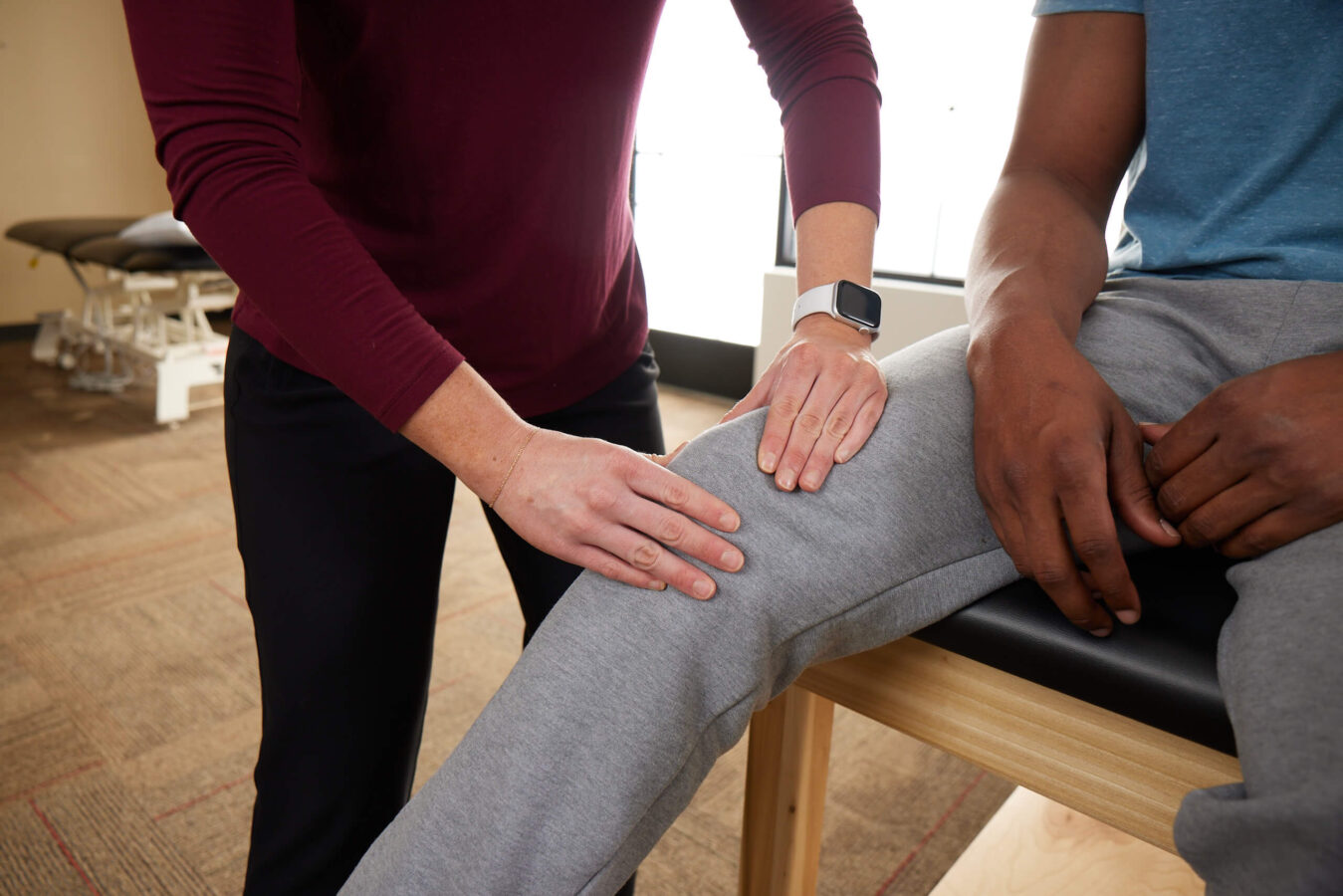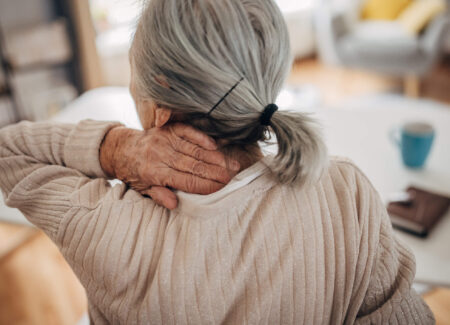
Knee pain is a common ailment affecting people of all ages at all stages of life. Pain anywhere in the body is a sign that something is wrong and needs to be addressed. Knee pain is no exception. Fortunately for many patients, pain relief is possible with non-surgical knee pain treatments. Read on to learn how to reduce knee pain without surgery.
The key to successfully treating knee pain without surgery is getting to the bottom of what’s causing it. Knee pain can indicate damage to structures of the knee or it may be a symptom of something happening in another part of the body like the ankle, foot, hips, and upper and/or lower leg. Your healthcare provider, physical therapist, and imaging tests will provide an accurate diagnosis.
Medical Conditions
Knee pain is a sign or symptom of several different medical conditions and diseases. Many fall under the umbrella of “arthritis.” Arthritis is not a single disease. It actually refers to more than 100 different conditions that cause pain, inflammation, and/or degeneration of the body’s joints.
Osteoarthritis is the most common form of arthritis, affecting older individuals who have significant joint “wear and tear.” In patients with rheumatoid arthritis, the body’s immune system attacks healthy cells in error, causing joint pain and stiffness. Gout is another form of arthritis where small crystals accumulate in and around the joints causing significant pain and swelling, usually in the lower part of the body.
Strains and Sprains
The knee contains certain connective tissues that create movement and support and stabilize the joint. These muscles, tendons, and ligaments can overstretch or tear with sudden or repetitive motions like jumping and twisting.
A fall or direct trauma to the knee or leg, as often happens in contact sports, can also damage these connective tissues as well. When these structures are compromised, you might experience localized pain and immobility at the knee, as well as discomfort and limited function throughout the legs and feet.
Overuse
Overuse injuries affect the muscles and/or joints and typically happen due to training and technique errors, or just going too hard or fast at your exercise or activity of choice. Runner’s knee is a common source of knee pain in active individuals (and not just runners!)
The term runner’s knee actually refers to numerous abnormalities and injuries that cause patellofemoral pain or pain in the kneecap which is located over the front of the knee joint. Runners, cyclists, and others who do activities that require a lot of bending of the knees may be more prone to knee pain if they don’t take time to rest.
Now, for the information you’ve been waiting for. Here are our top safe and practical methods for treating knee pain without surgery—in no particular order.
Anti-Inflammatories
Over-the-counter nonsteroidal anti-inflammatory drugs (NSAIDs) like ibuprofen and aspirin temporarily reduce knee pain and inflammation. Some patients require stronger prescription medications to obtain relief.
While anti-inflammatory medication can reduce immediate symptoms, they have also been shown to slow tissue healing. The inflammatory process that typically occurs during a traumatic or sudden injury actually helps promote the healing process.
Taking anti-inflammatories can delay healing and perpetuate injuries. Opioid medications can also reduce pain, but they mask injuries and also have highly addictive properties. Medication should be used under a provider’s supervision and in conjunction with other treatments.
Braces and Orthotics
Medical devices that reduce pressure on the affected knee and absorb the shock of movement may help reduce knee pain and other symptoms. Ask your physical therapist about knee braces, orthotic shoe inserts, and specific shoes to ease pressure on your knees and support your joints joint during activity.
Low-Impact Exercise
It may seem counterintuitive to keep moving with knee pain. However, gentle, low-impact physical activity is great for the joints and actually promotes tissue healing. As you build strength in the muscles and connective tissues in and around the knee, you are encouraging safe, healthy movement in these joints.
Aquatic therapy, yoga, walking, and strength-training are all ideal for stretching and strengthening the quadriceps, hamstrings, abductors, adductors, and gluteus maximus. These are the primary muscles that support and stabilize the knee. Exercise also increases blood flow to the area to promote healing, and lubricates the joints for smoother movement.
Injections and Infusions
Several minimally-invasive therapies are available to treat conditions associated with knee pain. Corticosteroid injections act quickly to lower inflammation and alleviate pain caused by swelling that compresses nerves and other tissues.
Some patients also find relief with hyaluronic acid injections. Hyaluronic acid is a substance found naturally in the body. It helps the skin stretch and flex, increases hydration, and lubricates joints. It can also be introduced into the body intravenously or by injection.
Current research suggests a single-session application of hyaluronic acid is safe and effective for knee pain in patients with osteoarthritis, with study participants reporting a decrease in pain after one treatment. (Results on repeated courses of these injections are not widely available.)
Platelets are tiny pieces of cells found in human blood, and in the spleen. They have two important purposes. They slow or stop bleeding so clots can form, and they help wounds heal. Platelet-rich plasma (PRP) injections, use the patient’s own blood to heal injured tissues.
Blood is placed in a centrifuge and spun at high speeds, causing platelets to concentrate, and removing red and white blood cells. PRP is then injected into the knee joint to speed healing. Although PRP therapy is growing in popularity, scientific research on this promising treatment is still very limited.
Lifestyle Changes
Our daily habits have a lot to do with how our knees (and the rest of our joints) feel and function. Your healthcare provider and physical therapist can recommend certain lifestyle modifications to improve your condition and prevent recurrence in the future.
For example, if you carry excess weight, consider the added pressure it puts on your joints—especially in the lower body. Losing just a single pound takes four pounds of pressure of your knees. That’s beneficial whether you have a joint condition, a recent injury, or you’ve just been training too hard.
Diet also plays a big part in knee joint health. Many joint conditions are triggered or made worse by inflammation in the body. Experts at Harvard Health recommend an anti-inflammatory diet that includes lots of fruits, vegetables, healthy fats, beans, whole grains, fish and lean meats to support good joint health and potentially prevent several common diseases.
Physical Therapy
Physical therapy is our final nonsurgical knee pain treatment option—not because it’s the least common or least effective. We round out our list of knee pain treatments with physical therapy because it encompasses many of the options discussed above.
Physical therapy is a comprehensive approach to diagnosing, treating, and preventing musculoskeletal conditions that lead to pain and inflammation and impact mobility and function. As “movement experts,” physical therapists are trained to address the root cause of knee pain and employ evidence-based techniques to give patients well-deserved relief.
Your physical therapy plan will likely consist of targeted stretching and strengthening exercises to make knee structures stronger and more flexible and hands-on massage and manual therapy to loosen stiff muscles. Most physical therapy patients leave with “homework.” The exercises and stretches you do at home will support your work in the clinic for a good outcome.
Ultimately, the best non-surgical treatment for knee pain varies from patient to patient. Treatment is customized based on the root cause of your knee pain, your symptoms, lifestyle, and health history. Your physical therapist is one member of your healthcare provider team that works together to provide an integrated treatment plan to facilitate a return to function.
In some cases—yes. Some research shows that with physical surgery, exercise, and other noninvasive treatments, patients are able to avoid knee surgery—or at least delay it—for some time.
In a cohort study out of England, 84% of participants with end-stage knee osteoarthritis delayed surgery for at least two years—and some avoided it altogether. Patients reported significant pain relief and better mobility with exercise, orthotics, injections, and education.
With that said, we cannot say for certain if your condition can be safely treated non-surgically. Some knee conditions that go untreated can result in more intense pain and permanent disability. Always discuss the risks, benefits, and alternatives of knee surgery with your healthcare team.
The reality is, surgical intervention is medically-necessary for some patients to preserve mobility and function, particularly for those living with knee osteoarthritis.
But don’t let the thought of surgery keep you from getting the appropriate treatment you need to stay active and independent. Knee replacement surgery and other procedures offer good results and allow patients to experience movement free from pain.
Pre- and post-surgical physical therapy are available to prepare you for your procedure and help you regain strength and promote recovery after. To learn more about the benefits of physical therapy for knee joint pain and other symptoms, find a physical therapy clinic near you.

